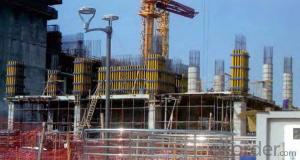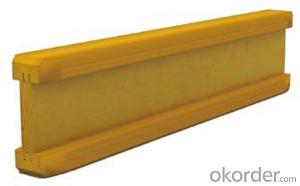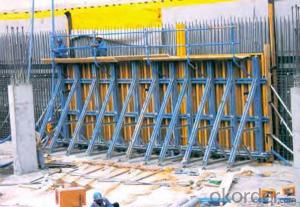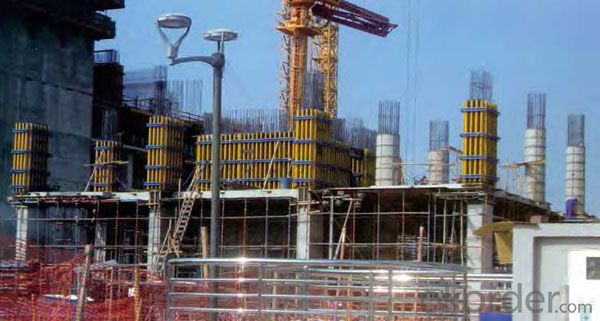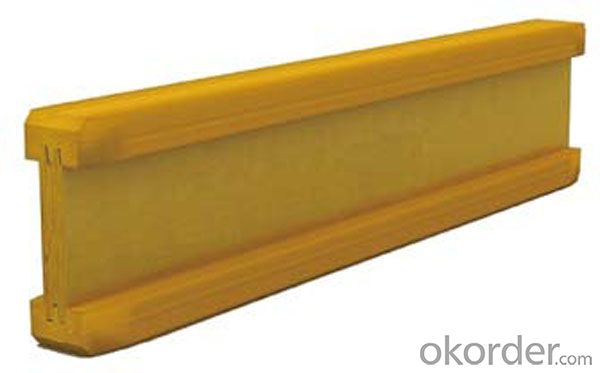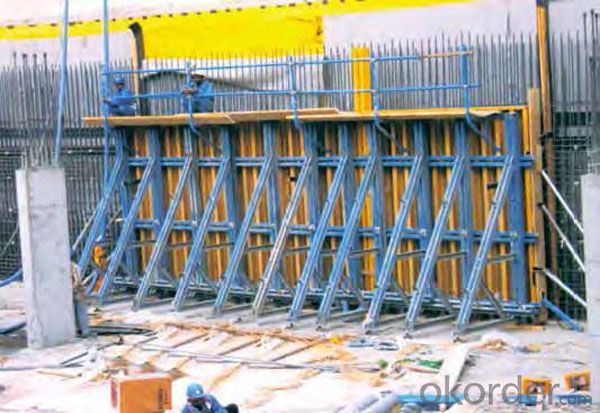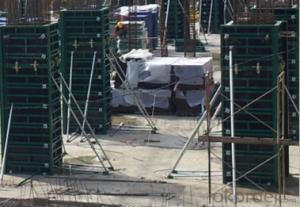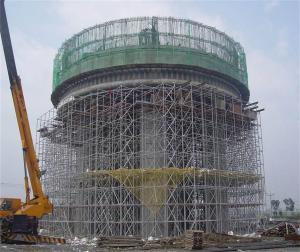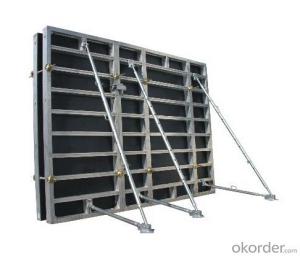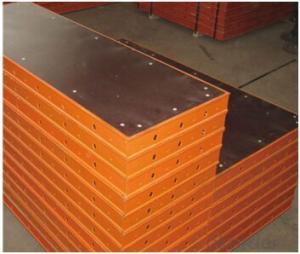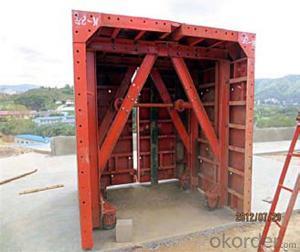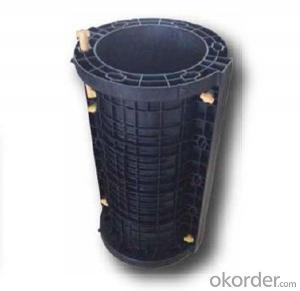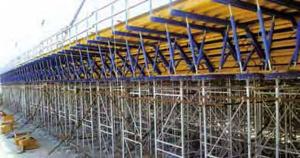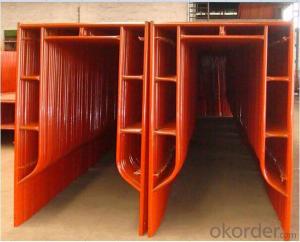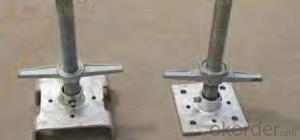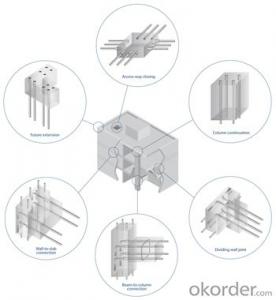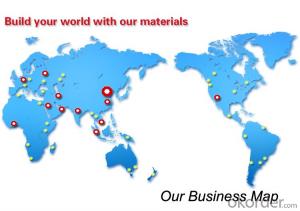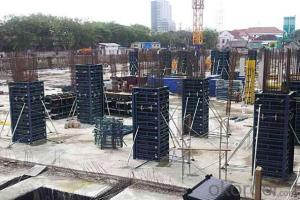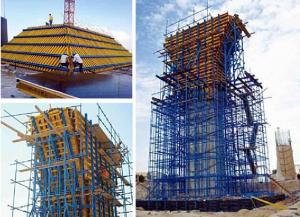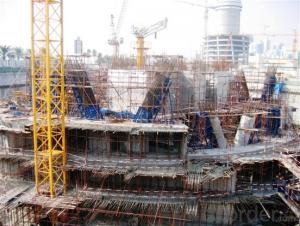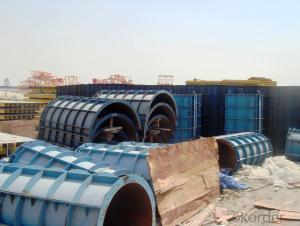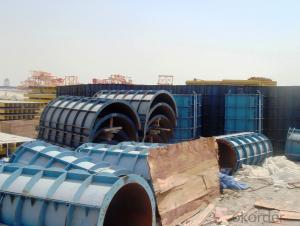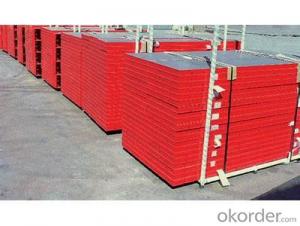Screw Jack For Scaffolding Formwork Scaffolding Tubes and Fittings Low Price
- Loading Port:
- Tianjin
- Payment Terms:
- TT OR LC
- Min Order Qty:
- 6000 set
- Supply Capability:
- 50000 set/month
OKorder Service Pledge
OKorder Financial Service
You Might Also Like
Screw Jack For Scaffolding Formwork Scaffolding Tubes and Fittings Low Price
Frame Scaffolding Formwork Scaffolding Construction with High Quality
Plastic Formwork Concrete Formwork Circular Column Used Scaffolding Props New Design
Developing with new technology materials, steel formworks is no longer a must in construction concrete process. More and more buildings are established with plastic formworks. And workers love this new formworks much more.
The advantages of plastic formworks:
1.First of all--light
Yes it is the first advantage of plastic formwork. It wins the great praise of both contractors and workers.
The biggest panel is 120×1500px,weights 10.5kg only. It can be lift and set up by one person easily, which means there is no need for cranes on site.Saves a lot of cost and time.
2.Easy set up
Different size of panels can firmly locked by simply turn the special handles to 90 degree. The Panels has rib on the back, which makes the system need not traditional wood blocks and nails. The panels have holes to fit tie rod, guarantee the strength of the whole system.
3.Modularity
Modular formworks composed by different size of panels..
4.Strength
The handles are made by high strength Nilon, each panel locked by at least 4 handles, which makes the whole system strong enough to pour 1000px walls.
5.Environment friendly
The system needs no cut and nail due to the variety size. Also it needs nearly no wood. The material can be recycled after broken, so it will not pollute the environment.
6.Consequent
Concrete does not stick to plastic formwork, thus the panels need no oil before using, and can be cleaned simply by water. The surface of the wall which build by modular formwork is smooth and without rework.
Screw Jack For Scaffolding Formwork Scaffolding Tubes and Fittings Low Price
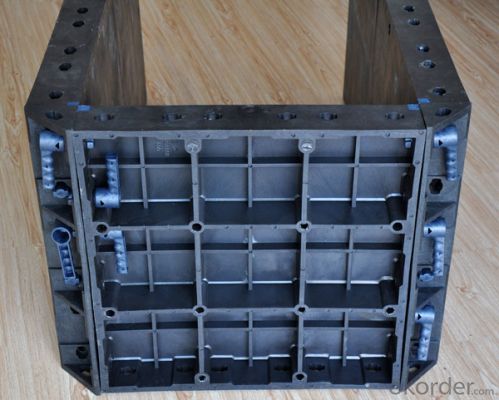
Screw Jack For Scaffolding Formwork Scaffolding Tubes and Fittings Low Price
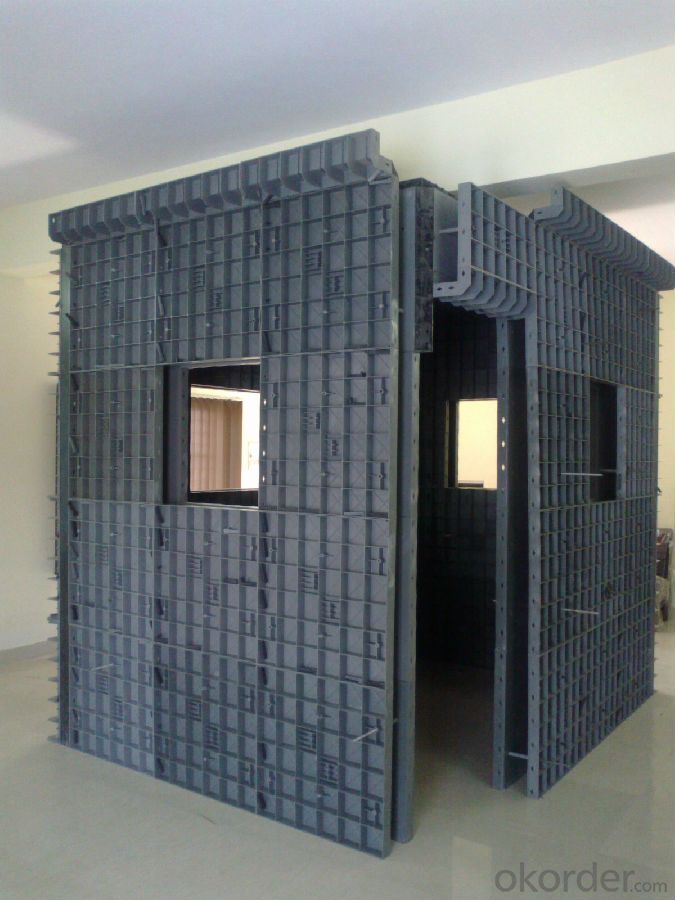
Screw Jack For Scaffolding Formwork Scaffolding Tubes and Fittings Low Price
Advantage
* Good loading capacity
* Easy to assemble and dismantle
* Stable and durable thanks to its structual design & automatic welding quality
* Customized solution helps you work safe, save cost and convenient
* Excellent quality for formwork & scaffolding with wide choices
Packing
in bulk or in bundle, or as requested
Shipping
15-20 Days.
Normally small orders, it needs just 15-20 business days to the port. For goods with stock, it would be even shoter.
Screw Jack For Scaffolding Formwork Scaffolding Tubes and Fittings Low Price
Other scaffolding & formwork products:
(1) Scaffolding System:
Including Ringlock Scaffolding System and accessories; Cuplock Scaffolding System and accessories; Kwikstage Scaffolding System and accessories; Haki Scaffolding System and accessories;
(2) Scaffolding Frame & Accessories:
Including Walk Through Frame Scaffolding; Ladder Frame Scaffolding; Accessories; we also can make scaffolding according to your samples or drawings.
(3) Scaffolding Couplers/Clamps:
We can produce all kinds of forged and pressed couplers, including British type couplers, American type couplers, German type couplers, Italian type couplers ,fence couplers, BRC coplers and so on. We also can produce according to your drawings or samples.
FAQ Screw Jack For Scaffolding Formwork Scaffolding Tubes and Fittings Low Price
Why Us?
We are one of the Top 500 in the world, largest construction materials supplier in China. Also we are a state-owned company and respond to every customer with large and also small orders.
We own professional manufacturers with powerful producing capacity.
Extensive and comprehensive quality control system
Excellent products with competitive prices.
Efficient services in pre and after sale.
Full energy with affluent experience team.
- Q: How does steel frame formwork accommodate for expansion and contraction of concrete?
- Steel frame formwork accommodates for the expansion and contraction of concrete through its design and construction. Firstly, steel frame formwork allows for the placement of expansion joints in the concrete structure. These joints are created by leaving gaps in the formwork where the concrete can expand and contract without causing damage to the overall structure. Additionally, steel frame formwork is built with adjustable connections that allow for slight movement and shifting of the formwork as the concrete expands or contracts. These connections can be tightened or loosened as needed to accommodate for any changes in the dimensions of the concrete. Furthermore, steel itself has a relatively high coefficient of thermal expansion, which means it expands and contracts more compared to other materials. This property of steel helps to absorb some of the expansion and contraction stresses that the concrete may experience. The steel frame formwork acts as a buffer, absorbing and distributing these stresses to prevent cracking or distortion in the concrete. Overall, steel frame formwork is designed to provide flexibility and adaptability to the concrete structure, allowing it to expand and contract without compromising its integrity. This ensures the long-term durability and stability of the concrete construction.
- Q: How is a steel frame formwork system assembled and disassembled?
- A steel frame formwork system is assembled by connecting prefabricated steel frames together in the desired configuration. The frames are then secured in place using clamps or pins. Once the concrete is poured and set, the system is disassembled by removing the clamps or pins and dismantling the steel frames, allowing for easy removal of the formwork.
- Q: What are the different types of formwork systems that can be used in conjunction with steel frame formwork?
- There are various formwork systems available that can be used alongside steel frame formwork. These include: 1. Timber formwork: Timber formwork is widely used and involves using timber boards or plywood to create the formwork structure. It is versatile, cost-effective, and easy to work with, making it suitable for a range of concrete structures such as walls, columns, beams, and slabs. 2. Aluminum formwork: Aluminum formwork is a lightweight and durable system consisting of interconnected aluminum panels. It is known for its high strength-to-weight ratio, allowing for faster construction and reduced labor costs. This type of formwork is commonly used for repetitive structures like residential buildings and commercial complexes. 3. Plastic formwork: Plastic formwork is gaining popularity due to its versatility and ease of use. It is made of lightweight and durable plastic panels that can be easily assembled and disassembled. Plastic formwork is suitable for various concrete structures, including walls, columns, and slabs. It offers advantages such as lower labor costs, reduced waste, and improved construction speed. 4. Fiberglass formwork: Fiberglass formwork is lightweight and strong, made of fiberglass panels capable of withstanding high concrete pressures. It is suitable for different concrete structures, including walls, columns, beams, and slabs. Fiberglass formwork offers benefits such as easy handling, reduced labor costs, and improved construction speed. 5. Modular formwork: Modular formwork involves using standardized components to create different formwork configurations. It can be integrated with steel frame formwork by combining the steel frames with the modular components. Modular formwork is highly flexible and adjustable to meet various construction requirements. It is suitable for complex structures and can be reused, making it cost-effective. In summary, these formwork systems offer advantages such as versatility, cost-effectiveness, ease of use, and increased construction speed. The choice of formwork system will depend on factors like project requirements, budget, and timeline.
- Q: What is steel wood formwork?
- Steel wood template that is the combination of steel and wood template, is made of special steel frame plywood (wood). The frame is made of F steel with high strength, light weight and reasonable force. Panel for 12mm plywood, reusable.Compared with traditional steel formwork, steel wood composite formwork has several advantages:
- Q: What are the different finishes that can be achieved with steel frame formwork?
- There are several different finishes that can be achieved with steel frame formwork in construction projects. These finishes are primarily determined by the type of formwork used and the techniques employed during the pouring and curing of the concrete. 1. Smooth Finish: Steel frame formwork can be designed to create a smooth finish on the concrete surface. This is achieved by using high-quality formwork materials, ensuring a tight fit between the formwork panels, and using appropriate release agents to prevent the concrete from sticking to the formwork. A smooth finish is often desired for architectural purposes or when the concrete surface needs to be easily cleaned or painted. 2. Textured Finish: Steel frame formwork can also be used to create various textures on the concrete surface. This can be achieved by using specialized form liners or molds that are attached to the formwork panels. These liners or molds can create patterns, imitate natural materials like wood or stone, or add decorative elements to the concrete surface. Textured finishes are often used in building facades, interior walls, or for aesthetic purposes. 3. Exposed Aggregate Finish: With steel frame formwork, it is possible to achieve an exposed aggregate finish on the concrete surface. This finish is achieved by using form liners or molds that create voids or recesses in the concrete. After the concrete has cured, the formwork is removed, and the surface is treated to expose the aggregates in the concrete mix. Exposed aggregate finishes are often used for sidewalks, driveways, or decorative concrete elements. 4. Stamped Finish: Steel frame formwork can be combined with stamping techniques to create a stamped finish on the concrete surface. This finish is achieved by using specialized stamps or patterns that are pressed into the concrete while it is still in a plastic state. The stamps can create various textures, imitate natural materials, or add decorative elements to the concrete surface. Stamped finishes are commonly used for patios, walkways, or other outdoor areas. In conclusion, steel frame formwork offers a wide range of finishes that can be achieved in concrete construction. These finishes include smooth, textured, exposed aggregate, and stamped finishes, each offering unique aesthetic and functional characteristics. The choice of finish depends on the desired outcome, project requirements, and architectural design considerations.
- Q: How does steel frame formwork handle architectural features such as openings and recesses?
- Steel frame formwork is highly versatile and can easily handle architectural features such as openings and recesses. It allows for customization and precision in design, enabling the creation of various shapes and sizes. The steel frames can be easily adjusted, modified, or removed to accommodate specific architectural features, ensuring a seamless integration of openings and recesses within the overall structure.
- Q: What are the environmental benefits of using steel frame formwork?
- The durability and long lifespan of steel frame formwork are among its main environmental advantages. Steel, being a highly durable material, can withstand harsh weather conditions and heavy use, thereby reducing the need for frequent replacements. As a result, the demand for raw materials is reduced, and the amount of waste generated over time is decreased. Moreover, steel frame formwork is extremely reusable. Unlike traditional timber formwork, which is typically discarded after a few uses, steel formwork can be utilized multiple times. This reduces waste during construction projects and minimizes the production of new formwork materials. Furthermore, steel is a recyclable material. At the end of its life cycle, steel formwork can be recycled and turned into new steel products. This lowers the demand for new materials and lessens the environmental impact of steel production. The use of steel frame formwork also contributes to energy efficiency. Steel is an excellent heat conductor, allowing it to regulate temperature during construction. Consequently, there is less need for additional heating or cooling, resulting in energy savings and a decreased carbon footprint. Lastly, steel frame formwork is fire-resistant, enhancing safety on construction sites and reducing the risk of fires. This not only protects workers and property but also minimizes the environmental impact of potential fires and the need for fire-related resources and waste management. To summarize, the environmental benefits of steel frame formwork include its durability and long lifespan, reusability, recyclability, energy efficiency, and fire resistance. These aspects contribute to waste reduction, resource conservation, energy savings, and overall sustainability in the construction industry.
- Q: What is the difference between the wheel steel frame and the aluminum frame
- 3 price, cheap steel, aluminum alloy expensive;4 weight, heavy steel, aluminum alloy light, a difference of more than 2 kg
- Q: What are the different types of supports used in steel frame formwork systems?
- There are several different types of supports used in steel frame formwork systems. 1. Adjustable Props: These are vertical steel members with adjustable height, commonly used to support horizontal formwork elements such as beams and slabs. They provide stability and can be easily adjusted to accommodate different heights. 2. Soldier Beams: Soldier beams are horizontal steel members that are used to support vertical formwork elements such as walls and columns. They are typically placed at regular intervals and help distribute the load evenly. 3. Tubular Scaffolding: Tubular scaffolding is a versatile support system that can be used in various formwork applications. It consists of steel tubes and couplers that can be easily assembled and adjusted to provide support for formwork elements. 4. H-Beams: H-Beams are horizontal steel members that are used to support vertical formwork elements. They are commonly used in large-scale construction projects and can provide a strong and stable support system. 5. Props with Forkheads: Props with forkheads are similar to adjustable props but have a fork-shaped head that allows them to support horizontal formwork elements such as beams and slabs more effectively. They provide a secure and stable support system. 6. Steel Bracing: Steel bracing is used to provide additional support and stability to the formwork system. It consists of steel members that are placed diagonally between the vertical and horizontal supports to prevent any lateral movement. Overall, these different types of supports play a crucial role in ensuring the stability and safety of steel frame formwork systems. They provide the necessary support for formwork elements and help distribute the load evenly, allowing for efficient and effective construction processes.
- Q: What are the different types of access systems used with steel frame formwork?
- There are several different types of access systems that can be used with steel frame formwork, depending on the specific requirements of the construction project. One commonly used access system is the ladder system. This involves attaching ladders to the steel frame formwork, which allows workers to easily climb up and down the formwork structure. Ladder systems are typically used for smaller structures or when access is only needed at certain points along the formwork. Another type of access system is the stair tower system. This involves constructing a separate tower structure alongside the steel frame formwork, which contains stairs or a ladder system. Stair tower systems are more commonly used for larger structures or when access is required at multiple levels of the formwork. In some cases, a platform system may be used as an access system with steel frame formwork. This involves constructing a platform structure that is attached to the steel frame formwork, providing a stable and secure platform for workers to access the formwork. Platform systems are often used when there is a need for extended access or when multiple workers need to access the formwork at the same time. Additionally, a crane or hoist system may be used as an access system with steel frame formwork. This involves using a crane or hoist to lift workers and materials up to the formwork structure. Crane or hoist systems are typically used when there is limited space for traditional access systems or when heavy materials need to be lifted onto the formwork. Overall, the choice of access system for steel frame formwork will depend on factors such as the size and complexity of the structure, the level of access required, and the specific needs of the construction project.
Send your message to us
Screw Jack For Scaffolding Formwork Scaffolding Tubes and Fittings Low Price
- Loading Port:
- Tianjin
- Payment Terms:
- TT OR LC
- Min Order Qty:
- 6000 set
- Supply Capability:
- 50000 set/month
OKorder Service Pledge
OKorder Financial Service
Similar products
Hot products
Hot Searches
